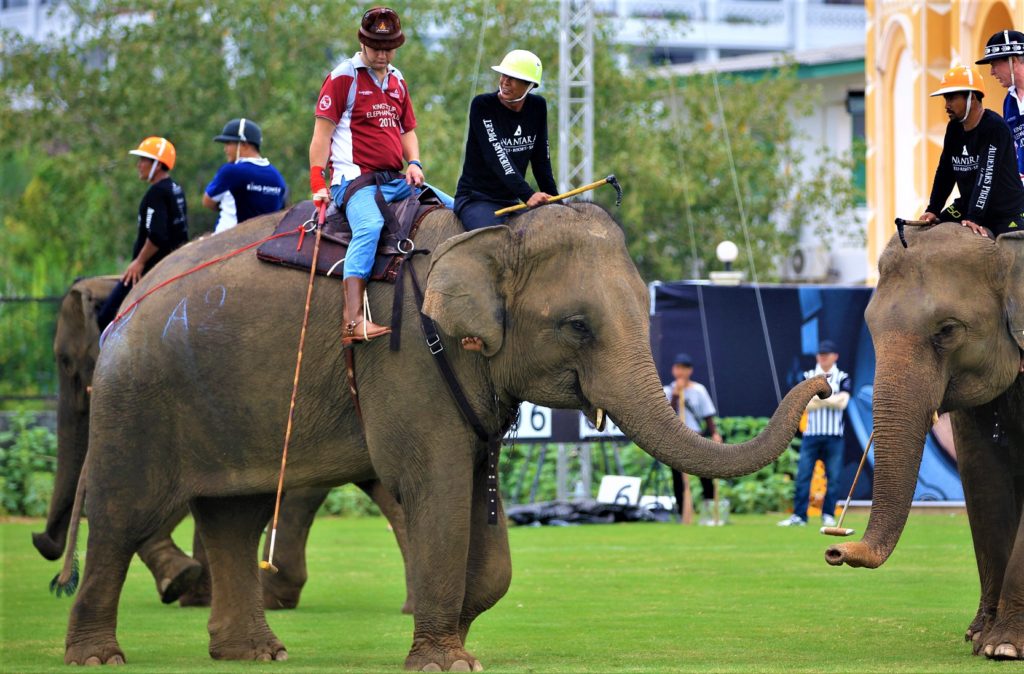Elephant Polo & everything you need to know about this royal sport


Elephant polo gives the royal sport of polo an interesting spin, which makes the sport larger-than-life. Here’s all you need to know about this sport today that may soon be discontinued as there is a concern raised over the welfare of the elephants engaged in playing the sport.
The royal sport of Polo has been a regal pastime of the royals of India. When the Britishers came to India and discovered the fine regal sport, they introduced a new spin to it. This new adaptation required the sport played on horses to be played by sitting on elephants. The twist of the regal sport was taken in great spirit and that’s how the game of elephant polo came about. Besides India, elephant polo became famous and was played in countries like Nepal, Sri Lanka, and Thailand also.
Advanced Equipment & Adapted Pitch Changes


The equipment of Elephant polo includes a standard polo ball and a six to ten feet cane stick with a polo mallet at the end. Originally when the sport was first played, a soccer ball was used, but now that has been replaced by a standard polo ball.
The pitch is three-quarters of the length of a standard polo pitch, due to the lower speed of the Elephants. Two people ride each Elephant, the elephants are steered by mahouts, while the player tells the mahout which way to go and hits the ball.
How the game was created
Elephant polo originated in Mehrauli, Nepal, where the game was played for the first time. Tiger Tops in Nepal remains the Headquarters of Elephant polo and the site of the World Elephant Polo Championships.
Elephant polo originated in 1982, the bizarre idea of two British entrepreneurs, Jim Edwards and James Manclark. The idea of playing polo with elephants was born one day when his friend and polo enthusiasts, Manclark came up with this idea. The game between friends has now turned into an annual tournament, which attracts polo enthusiasts and players from all over the world while offering a combination of sport and fun.
The Game Today
Today, Elephant polo has been registered as an Olympic sport in Nepal and is internationally recognized as an official sport. The World Elephant Polo Association acts as an umbrella association for the championship in Nepal, where eight teams fiercely compete for five days in November.
The bond between elephant and mahout who takes care of them grows over the years, which can be seen in the attention lavished on the creatures during the daily routine of feeding and cleaning. Before the game starts the mahouts paint their elephants with colored chalks for decoration.
Rules and regulations for Elephant polo have been adapted from the equine game. The pitch is shortened, the polo mallets are longer and if an elephant sits or lies down in the goal, the opposing team is given a penalty shot.
A Majestic Sight
Although the slow-moving nature of the game might seem like an advantage at first glance, it is elephant polo’s biggest challenge. Since elephants are rather clumsy, the accuracy when hitting the ball in this game is rather difficult and tricky.
Although played on the backs of heavy-weights mounts, elephant polo can at times appear as elegant as the light-footed ballet. Due to the slower speed of the elephants, the pitch size has been reduced from an original horse polo pitch to around 100 metres by 70.
Welfare of the Animals
Amidst a lot of uproar from an organization like PETA and other animal welfare bodies, the sport has been said to be taxing for the animal. This is why tiger Tops, the organizer of the annual International Elephant Polo Competition has announced that it would stop hosting the event to support the movement against animal cruelty.
This unusual sport has been attracting hordes of foreigners in the Jungle safari destination.
More from our site
Recent Posts
Luxury’s Most Recent & Vibrant Launches This Season
The luxury landscape is brimming with bold innovations, striking partnerships, and immersive experiences
The luxury landscape is brimming with bold innovations, striking partnerships, and immersive experiences
The PEAKLIFE Regatta 2025
From fashion designer Varoin Marwah’s Coastal Calm SS '25 splash show to a thrilling nautical spin on the sea, it was a magical weekend in Mumbai
From fashion designer Varoin Marwah’s Coastal Calm SS '25 splash show to a thrilling nautical…
Inside Louisiana’s Biggest Festival: 10 Things You Didn’t Know About Mardi Gras
More than a party, Mardi Gras is a cultural phenomenon!
More than a party, Mardi Gras is a cultural phenomenon!
Design Your Dream Home With These Expert Tips
A home that’s stylish, cosy, and truly yours!
A home that’s stylish, cosy, and truly yours!
Luxury in Fiji: Indulge in Paradise
From private island resorts to lavish overwater bungalows, this South Pacific paradise seamlessly blends indulgence with natural beauty
From private island resorts to lavish overwater bungalows, this South Pacific paradise seamlessly blends indulgence…
A Traveller’s Quest: Soorahi
This premium blend whisky brand aims to reflect a spirit of exploration and evolution in India’s alco-beverage landscape
This premium blend whisky brand aims to reflect a spirit of exploration and evolution in…

